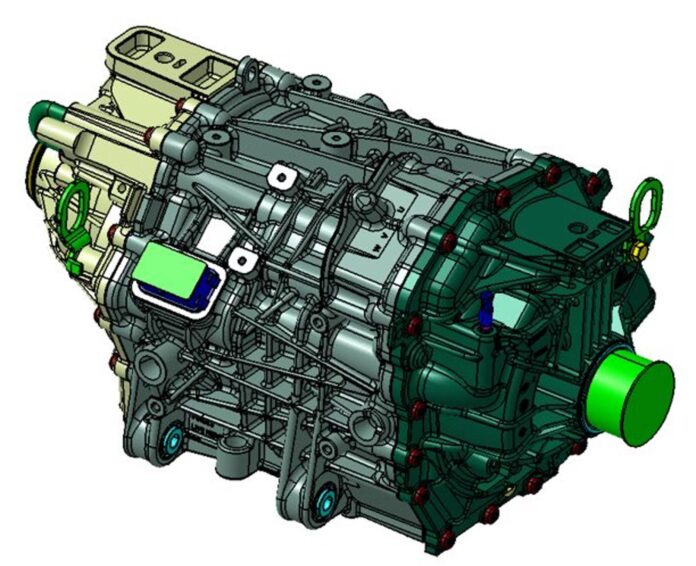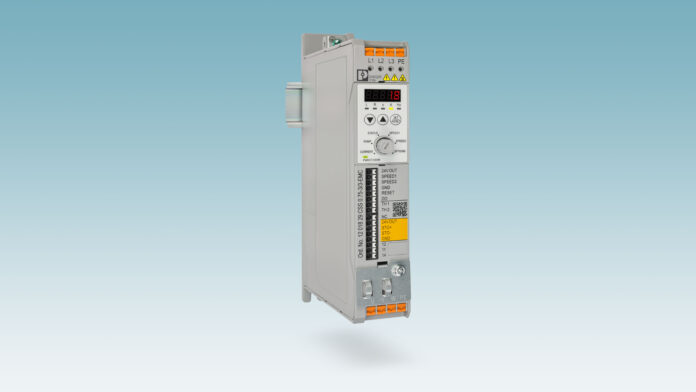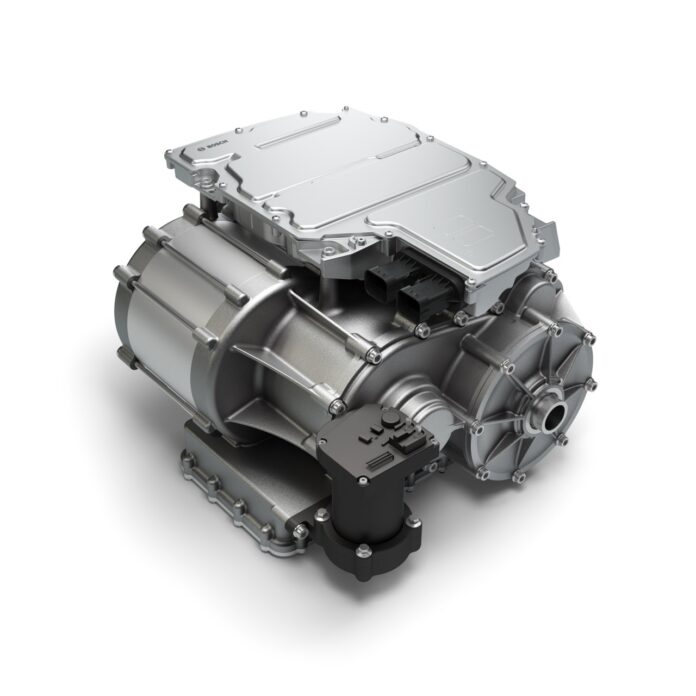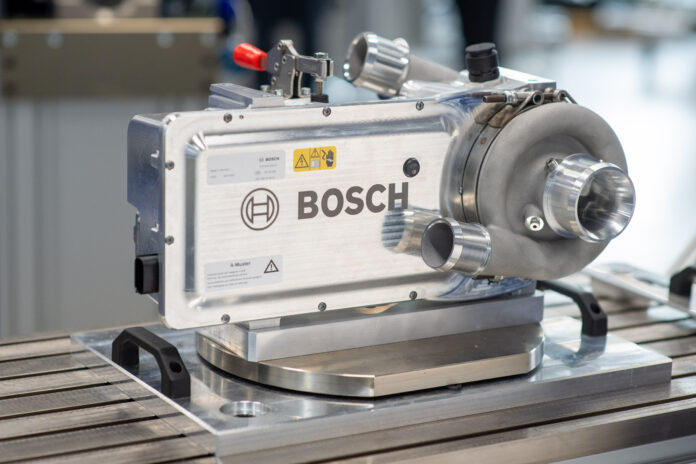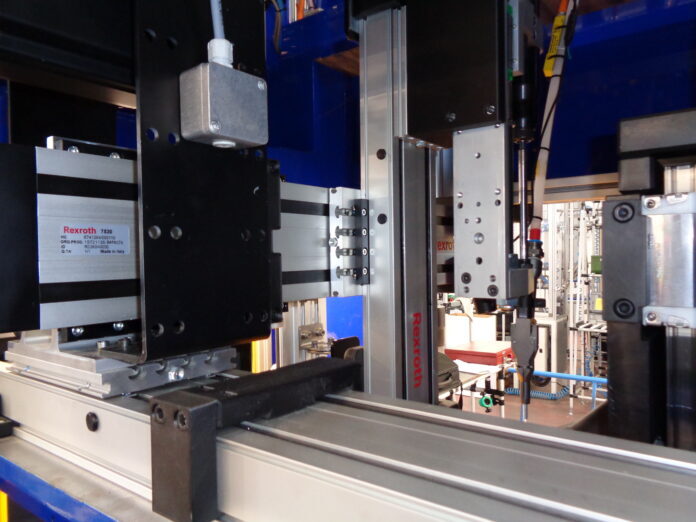The first design signed by Ford for the conversion into electric of the cars with “traditional” power supply is about to be fully unveiled. At present we know, as announced by Ford Performance Parts, that the name for the electric retrofit kit will be Eluminator, and it immediately connects with V8motors of Aluminator family, now proposed in fully electric version. They will be available in kits ready to be assembled and positioned under the bonnet of compatible cars, including old cars, too.
It seems the motor measures 570 mm of length, 345 mm of width and 370 mm of height, to suit the motor compartment of almost all vehicles. Moreover, it will feature 281 HP (210 kW) power, with 430 Nm torque, with a rotation speed of 13,800 revolutions and a final transmission ratio of 9.05 to 1.
The whole kit, which includes also the connection cables to the inverter and low-voltage ones, will be initially sold in the United States for 3,900 dollars. Is it really the start of a new revolution?
Ford kit for the electrical retrofit
Wireless batteries in electric Lotus?
Collaborations that express technological revolution and innovation are more and more frequent in the field of electric motors. In one of the latest partnerships, Analog Devices and Lotus are likely to be protagonists, committed to the implementation of a wireless battery management system (wBMS). With the elimination of 90% of the wiring equipping the car, the design freedom would increase and, at the same time, it would be possible to reduce by 15% the physical sizes of the battery pack and consequently the overall car weight. And all this without any kind of performance loss. The system is managed by a central unit that dialogues with the various battery modules by means of a wireless system.
Benefits should be mirrored on all future electric Lotus models, probably starting from the electric Type 132 SUV whose release on the market is expected in 2022.
«Lotus has a stellar reputation for building high-performance, long-lasting race and road vehicles, and many reach classic status,” said Roger Keen, General Manager of E-Mobility Group at Analog Devices. “Together, we’ve reimagined what is possible and developed a game-changer for the electric vehicle industry: a new ultralightweight powertrain architecture and a wireless battery management system that enables peak performance as well as a more sustainable environment for a healthier planet».
Finally, the floor is given to Richard Lively, Director, Propulsion and Chassis Engineering Lotus Cars: «We worked closely with Analog Devices to integrate wBMS into our new Lightweight Electric Vehicle Architecture (LEVA), which will be the basis for all future Lotus EVs. “The removal of the wire harness for wBMS ensures that Lotus can offer a lightweight solution that optimizes performance and is consistent with our brand of delivering powerful performance cars with exceptional handling».
The charging cable without control box
Recently, the Bosch giant has stated generating a turnover exceeding one billion Euros with electromobility and they expect to reach 5 billions within 2025, with the related driving assistance business growing by 40%. «Within 2035 – declared Stefan Hartung, member of the Board and president of the Mobility Solutions sector of Bosch – we foresee that 60% of all vehicles of new registration worldwide will be electric cars.
The company’s good ranking in the sectors of electro-mobility and of autonomous driving is helping the company to stand out successfully in this market context, where Bosch is investing not only in electric battery propulsion systems but also in fuel cell propulsion systems and is involved in projects by customers in Europe, China and United States. The latest technological novelty it has presented concerns a new flexible recharge cable for electric cars, provided with integrated control and safety technology and type-2 and household plug adapters. When you recharge with a 230-volt socket, too, you can give up the standard control box, which means it weighs less than three kilos, about 40% less than conventional charging cables. Besides, to free drivers from the task of looking for a place where recharging the vehicle while travelling, Bosch web-based recharge service offers the access to more than 200,000 recharging spots in Europe, including the problem-free payment and invoicing.
Wires for electric motors: a new standard for the coating
It is called Tau, it is a Turin start-up in electric mobility and advanced materials and it collected 6.75 million Euros of funding for its innovative wire for electric motors, with the target of developing and implementing state-of-the-art technologies starting from 2022, able to accelerate the transition to the Factory of the Future for e-mobility chain manufacturers.
The round involved a variety of international investors, including a consortium of two Middle-Eastern sovereign wealth funds, the Russian Direct Investment Fund (RDIF) and a German investment manager.
The start-up is specialized in wires and components for electric motors, with applications in the automotive, energy and agriculture sectors, and it has developed the DryCycle technology, which defines a new standard of wire coating. Through the strict use of solvent-free polymers, the solution eliminates the release of noxious VOC and greenhouse gases, whereas a simplified production process minimizes the use of resources, decreasing the energy consumption and wastes. LILIT technology by Tau provides the quality control to assure the reliability of the polymeric insulation in the magnetic wire and in electric steel.
The vision of Tau consists in doubling the power of electric motors in a determinate size and the funds of the recent capital increase will be used precisely to accelerate the development of new products, to enlarge the range of high-performance wires and to increase the industrial production, to provide global manufacturers of electrical cars, buses, trucks, aircrafts and ships starting from the beginning of 2022.
Intuitive speed starters
The safe, simple, and efficient operation of three-phase asynchronous motors is an important objective in a large number of applications. The Contactron Speed Starter from Phoenix Contact is the new device class that bridges the gap between motor starters and frequency converters with easy operation.
The operator interface consists of a rotary switch and three buttons with a display, so all settings can be made intuitively. This compact and cost-effective solution provides all of the necessary functions for different speeds. These include normal speed, creeping speed, soft start, energy efficiency and ramp functions, and even safe stopping with the Safe Torque Off function.
Thermo Management of lithium batteries
In the ambit of encapsulated coils and of industrial connections, Atam company consolidates its ranking in the automotive sector with an upgraded, compact and integrated solution: coil and connector developed according to the most severe design criteria to work under bonnet at the regulation of cooling circuits of lithium batteries mounted on hybrid and electric vehicles.
The ultra-compact solution proposed by Atam assures forefront performances to the primary devices used for the under-bonnet thermal management such as chiller, coolant pump and intercepting valves.
To operate for a long time and efficiently, the batteries of hybrid and electric cars must be able to maintain an optimal temperature, as constant as possible in a range included between +20 °C and -40 °C, irrespective of the external temperature because excessively high temperatures damage the service life of the battery pack whereas too low ones lead to an efficiency loss.
Therefore, we can state that the decay process of batteries can be contrasted by an optimal thermal management based on increasingly sophisticated control logics and drives. The efficiency of cooling devices strongly depends on integrated functional circuits regulated by coils and connectors with specific technical features, also providing the minimum overall dimensions.
Super-fast ball bearing for electric motors
In conformity with consumers’ demands and environmental protection requirements, vehicle manufacturers look for increasingly small and light components, to increase vehicles’ autonomy for each recharge. Consequently, transmission bearings, especially in electric motors, are subjected to higher and higher speed and performance requisites.
The previous generation of very high-speed ball bearings for EV motors was characterized by speeds of 1.4 million dmN and significant improvements in the cage and in the technology to increase their mechanical strength. With the third generation, NSK has aligned the solution to the demand for bearings able to reach even higher speeds. Besides the rotation at 1.8 million dmN (with the 28.5% increment), the new bearing is provided with a cage with optimized topology (OT). This process has allowed optimizing the material distribution inside the design space, with the target of obtaining the highest product performances. In the new bearing, the topology optimization has allowed maximising strength and minimizing weight, eliminating the parts that do not contribute in the strength and stiffness of the cage, so obtaining the optimal cage shape for high-speed rotation. The cage, made with a new resin with high stiffness degree, was designed in very short times exploiting a forefront simulation technology to assess its performances and production modalities.
Moreover, NSK lubricates these bearings with a purposely developed grease that reduces the resistance at high speeds and the consequent heat generation, extending the duration of grease and bearing and decreasing the seizure risk.
Transmissions: electric cars with gearbox?
The gearbox absence is a characteristic of the vast majority of electric cars, which rely on a system of direct transmission and reducer, turning to the torque of the electric motor.
This is not the opinion of Bosch, believing that with the gearbox EV A vehicles can improve the car performances, especially if a CVT transmission system is at stake.
It is a technology that continuously varies the ratio while driving to achieve the best motor performance in relation to power and torque.
The new transmission is under Bosch experimentation on board of a Volkswagen e-Golf: a slightly modified version of the standard CVT, called CVT4EV.
It seems there is an improvement of the car acceleration and speed and, besides, the transmission enables motors to be less powerful than those used currently; consequently, also battery packs can be reduced, so decreasing weights in favour of the general efficiency.
“CVT4EV – explained Gert-Jan van Spijk, head of CVT programme by Bosch Transmission Technology – widens the array of electric cars».
Electrical compressors with integrated power electronics
A high-speed electric motor and integrated power-electronics allow achieving competitive manufacturing costs. This is highlighted by a recent important job order in the electro-mobility field, where Bosch is protagonist with the supply of fuel-cell components to cellcentric, a 50% joint venture between Daimler Truck and Volvo Group. It is a long-term contract for the supply of electric compressors with integrated power electronics to share in making transports sustainable and neutral for climate by 2050. The component will be part of the fuel cell system of cellcentric for heavy commercial vehicles and for stationary applications. The use of a fuel cell propulsion system that exploits hydrogen allows making the vehicle neutral for climate. The electric compressor supplies the necessary quantity of filtered air and it is therefore one of the fundamental components of the system.
«Bosch – explained Uwe Gackstatter, President of the division Bosch Powertrain Solutions – offers the compressor in two power classes: 20 and 30 kW. The 30-kW size is calibrated for voltages from 450 to 850 volt, whereas the 20-kW one is suitable for 250-450-volt or 450-850-volt voltages. The compressor turbine reaches speeds of over 100,000 rpm. The combination of high-speed electric motor with integrated power electronics allows achieving competitive manufacturing costs. Moreover, silicon carbide semiconductors of silicon carbide used in power electronics by Bosch make this component highly efficient, precisely the characteristics cellcentric was looking for».
Production of electric motors: new automation frontiers
Two companies that have shaken their hands to improve the manufacturing world of electric motors are Bosch Rexroth, multinational specialized in industrial automation and motion of mobile operating machines, and McService, Modena design company the operates in the engineering sector and is specialized in the gearmotor, especially in the electric motor ambit. In recent years, it has collaborated with companies that produce electric motors and it is structuring technological solutions able to improve and to objectify manufacturing processes and, in this direction, about ten years ago, the meeting with Bosch Rexroth took place.
Let us come to innovation: the automated motor-closing machine ideated by the two companies has displaced processes from manual to automatic. Many assembling phases of the electric motor were carried out manually on a work bench, now instead all components are loaded by the machine and this proceeds to executing assemblies.
Such operations occur in what is called “hidden time”, that is to say a process that was previously carried out by the operator whereas now it is carried out by the machine in the same identical tine in which the operator performs another operation.
The machine can assess the work progress inside the job order (it knows whether it is at the beginning, half or end of the manufacturing batch) and inside each single production batch it knows whether each single motor has been closed correctly or if there are some anomalies. This machine can shorten the assembling times of electric motors, objectivating and making assembling data usable, due to linear axes and to the PLC intelligence that makes everything programmable and flexible.

